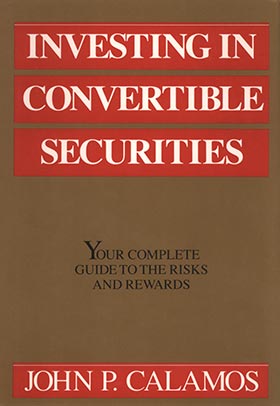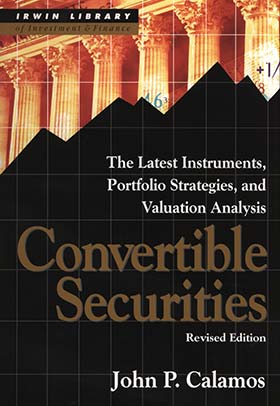 Investment Team Voices Home Page
Investment Team Voices Home Page
7 Reasons Why Companies and Investors Choose Convertible Securities
John P. Calamos, Sr., Founder, Chairman and Global Chief Investment Officer
How Convertible Bonds Work*
- A convertible bond is a regular corporate bond that has the added feature of being convertible into a fixed number of shares of common stock.
- Convertible bonds are debt instruments that pay interest and have a maturity date, which is currently about five years.
- The conversion feature of a convertible bond makes it more sensitive to the movements of the underlying stock, which is sometimes referred to as the “equity kicker.”
When I first began investing in convertible securities in the 1970s, they were essentially alternative investments that weren’t well known.
Investors are more familiar with convertibles today but are often still surprised to learn that convertibles have fueled growth and innovation for more than 150 years. The first convertible securities were issued by US railroad companies in the 1800s when the US was an emerging market and railroad companies were leading innovators. Today’s convertible market is a well-diversified global asset class of $364 billion that includes a range of opportunities, from auto manufacturers and leading biotech firms to small and mid-cap companies that may well be the leaders of tomorrow.
I believe the convertible market’s longevity and its continued bright prospects reflect the many benefits that convertibles can provide issuers and investors. Although the opportunities of convertibles could fill a book (I’ve written two), here’s a quick overview.
- Issuing convertibles is a quick and convenient way for companies to access capital. Companies can bring convertibles to market quickly by going directly to institutional investors. This can provide a strong incentive versus other forms of financing with longer IPO windows.
- Companies issue convertibles to lower their borrowing costs. Convertibles offer investors the opportunity for equity participation and maturities that are often shorter than nonconvertible debt. In exchange for these attractive features, companies can usually issue convertibles with lower coupons than comparable nonconvertible debt.
“It’s relatively simple to organize a corporation and provide for the issuance of common stocks and corporate bonds. It’s quite another matter to sell those securities to the investing public. Convertible securities came into being to make securities more attractive to the investing public.”

-John P. Calamos, Sr.
Investing in Convertible Securities (Longman, 1988)


- Convertibles give a company more control over its debt/equity ratios. The call feature allows a company to shift debt to equity, which can be especially attractive for companies that require capital to drive their growth plans. As a company’s stock price increases, convertibles may be called. Debt is converted to equity, cleaning up the balance sheets.
- Issuing convertible bonds may help keep a company’s stock price stable. When a company announces any type of financing, it often causes its stock price to decline in the short term. Typically, a convertible offering influences the stock price less and reduces the negative impact of adding a large amount of common stock to the market.
- For investors, the convertible structure offers risk-managed participation in the stock market. The conversion feature provides the opportunity for upside participation, while the convertibles’ fixed income features can cushion the impact of equity market drawdowns. The bond value may provide a floor, and through coupon income, investors are “paid to wait” for the market to turn.
- Investors are often attracted to convertibles’ reduced vulnerability to interest rate moves. The equity characteristics of convertible bonds have made them less susceptible to rising interest rates than non-convertible bonds. Many investors may welcome the reduced duration risk of shorter maturities as well.
- With active management, convertible instruments can be used to pursue an array of investment goals. Levels of equity and fixed income sensitivity vary among convertibles and for an individual convertible over time. Through active management, convertibles can support ranging asset allocation needs, including pursuing lower volatility equity exposure (such as our flagship Calamos Convertible Fund) and serving as an alternative to traditional fixed income funds (see our Calamos Market Neutral Income Fund). Convertibles can also be managed to provide a higher-octane approach to equities, as our recently launched Calamos Convertible Equity Alternative ETF (CVRT) does.
We see tailwinds for convertible issuance in 2024
Just like other capital market activity, convertible market issuance ebbs and flows. In 2023, companies issued convertibles at a far faster clip than 2022. We’re optimistic that the current interest rate environment and slow but continued economic growth, set the stage for healthy issuance in the coming years. Companies are likely to seek capital to drive expansion but will want to keep borrowing costs down with interest rates at levels higher than we have seen in quite some time.
Additionally, many traditional, nonconvertible bonds are coming due in the next couple of years. As this “maturity wall” approaches, companies need to refinance debt and will likely find the lower borrowing costs associated with a convertible to be more attractive than they were when interest rates were abnormally low.
Meanwhile, we expect strong demand as well, as investors seek ways to participate in the stock market with less exposure to downside, or to diversify their portfolios without taking the interest rate volatility associated with traditional bonds.
Learn more about convertible securities
Calamos Convertible Capabilities: Insights and resources about the many ways Calamos Investments uses convertibles to help investors address asset allocation goals
Calamos Investments’ Legacy in Convertibles: Reflections from our Founder: A post about the evolution of the convertible market and Calamos’ heritage in convertibles
*Note: there are many different types of convertible instruments, we’ve chosen convertible bonds for the sake of simplicity and given they make up the bulk of the convertible market.
This piece draws upon some of my earlier publications, including: Investing in Convertible Securities, Your Complete Guide to the Risks and Rewards, John P. Calamos, Sr. (Longman, 1988), Convertible Securities: The Latest Instruments, Portfolio Strategies and Valuation Analysis, John P. Calamos (McGraw Hill, 1998); Convertible Securities, Structures, Valuation, Market Environment and Asset Allocation, John P. Calamos, Sr., with contributions from Eli Pars, www.calamos.com.
Source for convertible market size: BofA Global Research.
IMPORTANT INFORMATION
Before investing, carefully consider the fund’s investment objectives, risks, charges and expenses. Please see the prospectus and summary prospectus containing this and other information which can be obtained by calling 1-866-363-9219. Read it carefully before investing.
Duration is a measurement of a bond's interest rate risk that considers a bond's maturity, yield, coupon and call features. The maturity date refers to the moment in time when the principal of a fixed income instrument must be repaid to an investor.
An investment in the Fund(s) is subject to risks, and you could lose money on your investment in the Fund(s). There can be no assurance that the Fund(s) will achieve its investment objective. Your investment in the Fund(s) is not a deposit in a bank and is not insured or guaranteed by the Federal Deposit Insurance Corporation (FDIC) or any other government agency. The risks associated with an investment in the Fund(s) can increase during times of significant market volatility. The Fund(s) also has specific principal risks, which are described below. More detailed information regarding these risks can be found in the Fund's prospectus.
The principal risks of investing in the Calamos Market Neutral Income Fund include: equity securities risk consisting of market prices declining in general, convertible securities risk consisting of the potential for a decline in value during periods of rising interest rates and the risk of the borrower to miss payments, synthetic convertible instruments risk, convertible hedging risk, covered call writing risk, options risk, short sale risk, interest rate risk, credit risk, high yield risk, liquidity risk, portfolio selection risk, and portfolio turnover risk.
The principal risks of investing in the Calamos Convertible Fund include: convertible-securities risk consisting of the potential for a decline in value during periods of rising interest rates and the risk of the borrower to miss payments, synthetic-convertible-instruments risk consisting of fluctuations inconsistent with a convertible security and the risk of components expiring worthless, foreign-securities risk, equity-securities risk, interest-rate risk, credit risk, high-yield risk, portfolio-selection risk and liquidity risk. As a result of political or economic instability in foreign countries, there can be special risks associated with investing in foreign securities, including fluctuations in currency exchange rates, increased price volatility and difficulty obtaining information. In addition, emerging markets may present additional risk due to potential for greater economic and political instability in less developed countries.
Foreside Fund Services LLC is the distributor of CVRT.
The principal risks of investing in the Calamos Convertible Equity Alternative ETF (CVRT) include: Authorized Participant Concentration Risk- Only an Authorized Participant may engage in creation or redemption transactions directly with the Fund, and none of those Authorized Participants is obligated to engage in creation and/or redemption transactions. Convertible Securities Risk- The value of a convertible security is influenced by changes in interest rates, with investment value declining as interest rates increase and increasing as interest rates decline. Debt Securities Risk- Debt securities are subject to various risks, including interest rate risk, credit risk and default risk. Equity Securities Risk- The securities markets are volatile, and the market prices of the Fund's securities may decline generally. Foreign Securities Risk- Risks associated with investing in foreign securities include fluctuations in the exchange rates of foreign currencies that may affect the US dollar value of a security, the possibility of substantial price volatility as a result of political and economic instability in the foreign country, less public information about issuers of securities, different securities regulation, different accounting, auditing and financial reporting standards and less liquidity than in US markets. High Yield Risk- High yield securities and unrated securities of similar credit quality (commonly known as "junk bonds") are subject to greater levels of credit and liquidity risks. New Fund Risk- The Fund is a recently organized investment company with a limited operating history. As a result, prospective investors have a limited track record or history on which to base their investment decision. Options Risk- The Fund's ability to close out its position as a purchaser or seller of an over-the-counter or exchange-listed put or call option is dependent, in part, upon the liquidity of the option market. Non-Diversification Risk- The Fund is classified as "non-diversified" under the 1940 Act. As a result, the Fund is only limited as to the percentage of its assets which may be invested in the securities of any one issuer by the diversification requirements imposed by the Internal Revenue Code of 1986, as amended. Portfolio Turnover Risk- The portfolio managers may actively and frequently trade securities or other instruments in the Fund's portfolio to carry out its investment strategies. Small and Mid-Sized Company Risk- Small and mid-sized company stocks have historically been subject to greater investment risk than large company stocks. Synthetic Convertible Instruments Risk- The value of a synthetic convertible instrument will respond differently to market fluctuations than a convertible security because a synthetic convertible instrument is composed of two or more separate securities, each with its own market value.
024003 0124
Cookies
This website uses cookies. By continuing to use this website, you consent to the use of cookies. Learn more about our cookie usage.

